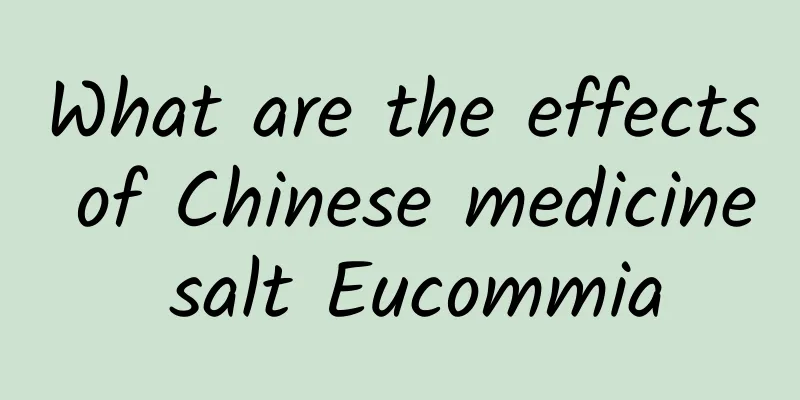What are the effects of Chinese medicine salt Eucommia

|
Friends who are familiar with traditional Chinese medicine pharmacology will probably not be too unfamiliar with Eucommia ulmoides. Eucommia ulmoides is a common Chinese medicinal material. Salted Eucommia ulmoides refers to Eucommia ulmoides that is soaked in salt water and then fried. Like Eucommia ulmoides, Salt Eucommia ulmoides has a very high medicinal effect. It can not only nourish the kidney and stabilize the fetus, but also has a good effect on lowering blood pressure. Today I will mainly introduce to you the effects of the traditional Chinese medicine salt Eucommia ulmoides. Let’s take a look. Eucommia ulmoides, as an ancient tree species, is also a traditional Chinese medicine for nourishing the kidney and liver. To make salted Eucommia ulmoides, first add appropriate amount of boiling water to dissolve it, take the Eucommia blocks or strips, mix them with the salt water thoroughly and absorb them, then put them in a pot, stir-fry over low heat until there are slight charred spots, take them out and dry them. (For every 100 jin of Eucommia ulmoides, use 3 jin of salt) After frying, the Eucommia gum is destroyed and the effective ingredients are easy to fry out. Salt Eucommia can nourish the kidney and strengthen the bones, stabilize the fetus, treat kidney deficiency and low back pain, impotence and spermatorrhea, fetal movement disorder, and hypertension. It is used for low back and knee pain, lower limb weakness, impotence, frequent urination and other symptoms caused by liver and kidney deficiency. It is used for bleeding during pregnancy, fetal movement disorder, or habitual abortion due to liver and kidney deficiency, coldness in the lower abdomen, etc. 3 It is used in modern clinical practice for hypertension and has a reliable blood pressure lowering effect. For high blood pressure, fried Eucommia ulmoides is better than raw Eucommia ulmoides. However, repeated administration can easily lead to tolerance. Notes on use: Stir-frying is better than using it raw. The whole body of Eucommia ulmoides is a treasure, and its bark is used as medicine. It has the effects of nourishing the liver and kidneys, strengthening the essence and bones, stabilizing the pregnancy, keeping fit, losing weight, and delaying aging. The above content introduces the functions and effects of salt Eucommia in great detail. I hope that friends can have a deeper understanding of salt Eucommia. Salt Eucommia can not only be used in combination with other different Chinese medicinal materials to achieve the effect of treating diseases, but can also be taken alone to treat kidney deficiency, impotence and premature ejaculation, and delay aging. Friends can always keep it at home! |
<<: What are the effects and functions of bamboo ru
Recommend
For the first time! Chinese scientists successfully constructed a human immune system development map
Recently, researchers from the Shenzhen Institute...
The efficacy and function of spicy vegetables
The effects and functions of spicy vegetables are...
Eurostat: 13.4% of EU residents purchased paper books online in 2023
In 2023, the proportion of EU residents purchasin...
The efficacy and function of water chestnut leaves
Water chestnut leaf is a kind of traditional Chin...
Using vegetable oil instead of milk? What is non-dairy ice cream?
Some time ago, a certain brand positioned as high...
Psychological research: Don't spend all your time together, or the cost will be...
Leviathan Press: In the movie Little Children (20...
Wenchang chicken, Danzhou chicken, ant chicken...the "chicken secrets" of Hainan that you don't know!
1. Is Wenchang chicken the only chicken in Hainan...
The efficacy and function of cinnabar vine
The Chinese medicinal herb Cinnabar vine is a rel...
The efficacy and function of red leaves
Traditional Chinese medicine often has unexpected...
The efficacy and function of elm kernel sauce
Elm kernel sauce is a common Chinese medicinal ma...
What is the method of nourishing the kidney and consolidating essence?
Traditional Chinese medicine believes that if the...
If you keep losing hair, is there something wrong with your body? Here’s one tip to help you check yourself!
Hair loss has become one of the most common "...
Patron? Protector? Friend? The relationship between the founding father and the sculptor
In the great sculpture era with many stars shinin...
The efficacy and function of yellow back grass fruit
There are so many medicinal herbs in the world, a...
Why is juniper pollen so popular? The scientific truth behind the "smoking" of the top streamers
This spring, juniper pollen has become a "to...









